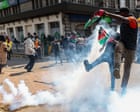
In recent days, the streets of Kenya have reverberated with the sounds of protest, as citizens gathered to honor the lives lost during last year’s anti-government demonstrations. Yet, what began as a solemn commemoration quickly escalated into chaos. The events unfolded on the 25th of June, when thousands of people took to the streets of Nairobi and other cities across the nation.
This particular gathering had a deeper significance. It marked an anniversary of unrest linked to previous grievances with governmental actions. However, tensions rose swiftly as police forces sought to quell the masses using tear gas and water cannons, leading to further escalation. Amnesty International’s Kenyan branch confirmed a concerning report: at least 16 individuals were killed amidst the unrest, with injuries surpassing 400.
Irũngũ Houghton, the Executive Director of Amnesty International Kenya, shed light on the situation, stating that the deaths were largely attributed to police interventions. These numbers were verified with the collaboration of the Kenya National Commission on Human Rights, a government-funded body dedicated to oversight and protection of human rights.
The scenes in Nairobi, particularly within the city centre, were accompanied by images of determined protestors facing off against law enforcement tactics. Such methods, while aimed at restoring order, starkly highlighted the escalating tension between the state and its citizens. Participating individuals, with memories of last year’s events still vivid, appeared determined to both seek justice and demand accountability.
Transitions between peace and protest are often fraught with complexities, and this occasion was no different. Despite the tumult, the undercurrent of hope remains, underscored by the people’s resilience and their unwavering calls for democracy and transparency. These events serve as a reminder of the broader issues at play within the nation, emphasizing the continual need for dialogue and reform.
Meanwhile, across the globe in Europe, another significant event unfolded as European leaders convened to discuss measures concerning Russian sanctions. The backdrop of this meeting was the EU’s attempt to navigate a consensus on steps to phase out Russian energy imports. However, these discussions saw a division, with Hungary and Slovakia opposing the proposed actions.
Despite these differences, progress was evident in the form of renewed agreements to extend the existing sanctions against Russia. Poland’s Prime Minister Donald Tusk, speaking after a late-night briefing, expressed satisfaction with the collective decision. He emphasized the importance of unity within the European bloc, highlighting the broader geopolitical stakes and the necessity of collaborative efforts in such matters.
The interconnectedness of global events becomes apparent as we shift focus once more, this time to the United States. Here, in the state of California, the intricate challenges faced by immigrant families came to the fore. Erika Perez, a dedicated firefighter, faced personal upheaval as her mother was deported to Mexico despite having lived and contributed to the U.S. for over thirty-five years. This story underscores the ongoing conversations surrounding immigration policies and their profound impacts on familial structures and individual lives.
As we navigate these diverse narratives, the atmosphere remains one of striving towards understanding and resolution. Each of these stories, from protests on the African continent to policy discussions within the European Union and personal narratives in North America, forms part of a larger tapestry that reflects the current state of our world.
In the spirit of journalistic dedication, it remains vital to present these unfolding narratives with empathy and clarity. Through discourse, both local and international communities continue to address enduring issues, seeking pathways that aspire toward greater harmony and justice for all. As these events evolve, they invite both reflection and constructive dialogue, urging us to remain engaged, informed, and hopeful for brighter tomorrows.
Source: {link}
